ACC302 Strategic Management Accounting: Philips Balanced Scorecard
VerifiedAdded on 2023/04/20
|11
|1410
|135
Report
AI Summary
This report assesses Philips Electronics' financial performance using the balanced scorecard approach, examining its application for performance measurement and control. It reviews key performance indicators, including profitability, sales, and shareholder equity, to determine the company's leading and lagging indicators. A strategy map illustrates the relationships between different objectives, such as financial performance, customer satisfaction, internal processes, and learning and growth. The report also identifies issues related to the implementation of the balanced scorecard, such as cost and time constraints. The analysis concludes that the balanced scorecard helps Philips set objectives and maintain control over its operations, providing valuable insights for decision-making.
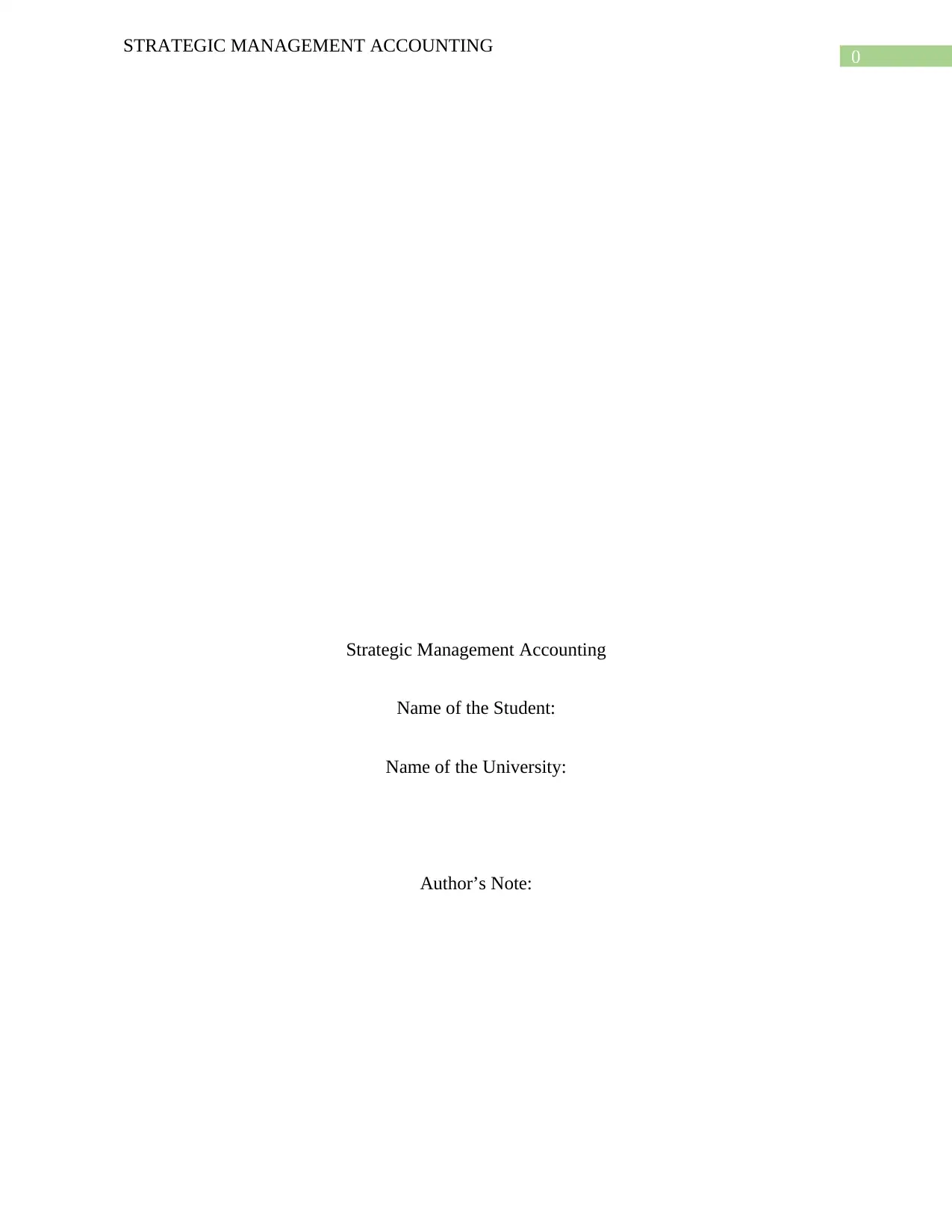
0
STRATEGIC MANAGEMENT ACCOUNTING
Strategic Management Accounting
Name of the Student:
Name of the University:
Author’s Note:
STRATEGIC MANAGEMENT ACCOUNTING
Strategic Management Accounting
Name of the Student:
Name of the University:
Author’s Note:
Paraphrase This Document
Need a fresh take? Get an instant paraphrase of this document with our AI Paraphraser
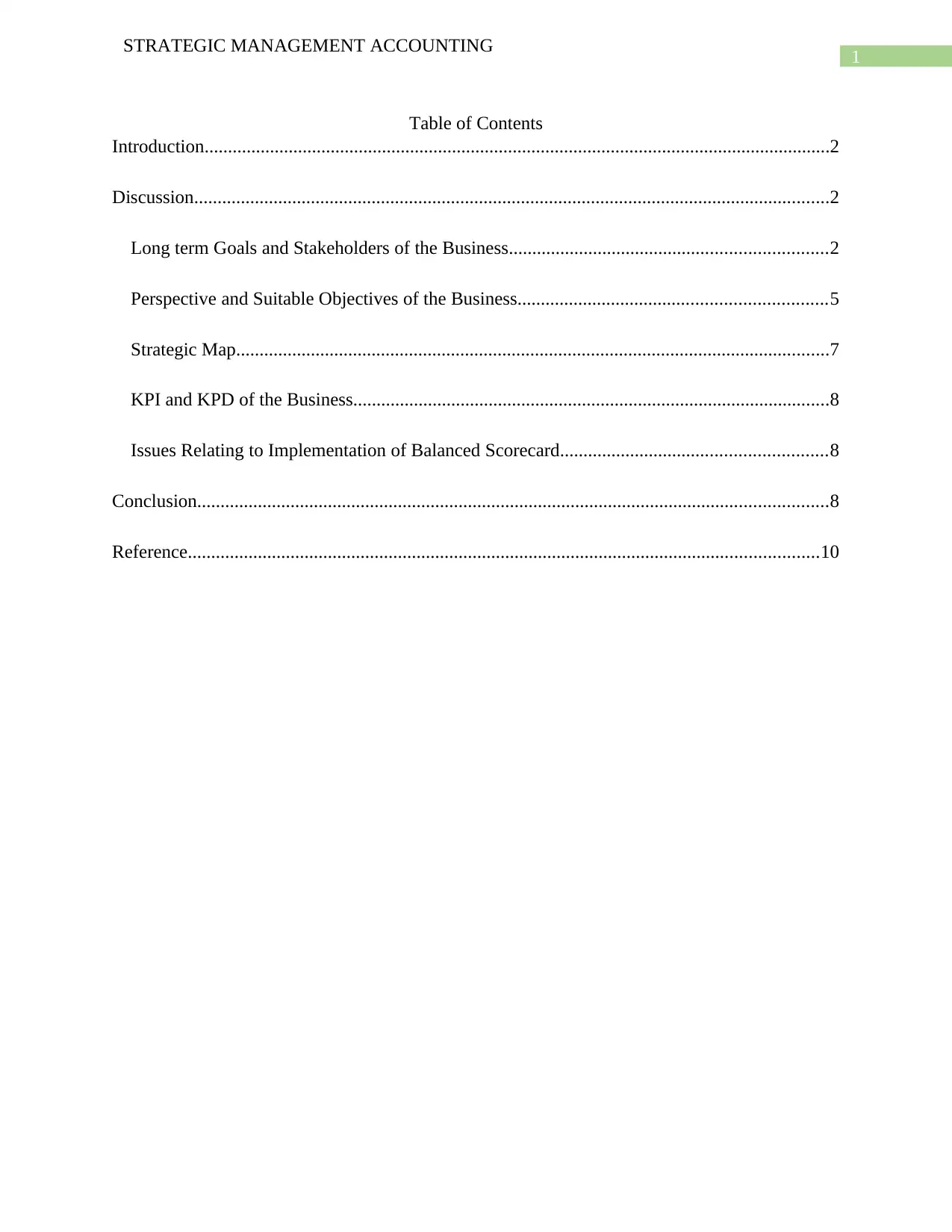
1
STRATEGIC MANAGEMENT ACCOUNTING
Table of Contents
Introduction......................................................................................................................................2
Discussion........................................................................................................................................2
Long term Goals and Stakeholders of the Business....................................................................2
Perspective and Suitable Objectives of the Business..................................................................5
Strategic Map...............................................................................................................................7
KPI and KPD of the Business......................................................................................................8
Issues Relating to Implementation of Balanced Scorecard.........................................................8
Conclusion.......................................................................................................................................8
Reference.......................................................................................................................................10
STRATEGIC MANAGEMENT ACCOUNTING
Table of Contents
Introduction......................................................................................................................................2
Discussion........................................................................................................................................2
Long term Goals and Stakeholders of the Business....................................................................2
Perspective and Suitable Objectives of the Business..................................................................5
Strategic Map...............................................................................................................................7
KPI and KPD of the Business......................................................................................................8
Issues Relating to Implementation of Balanced Scorecard.........................................................8
Conclusion.......................................................................................................................................8
Reference.......................................................................................................................................10
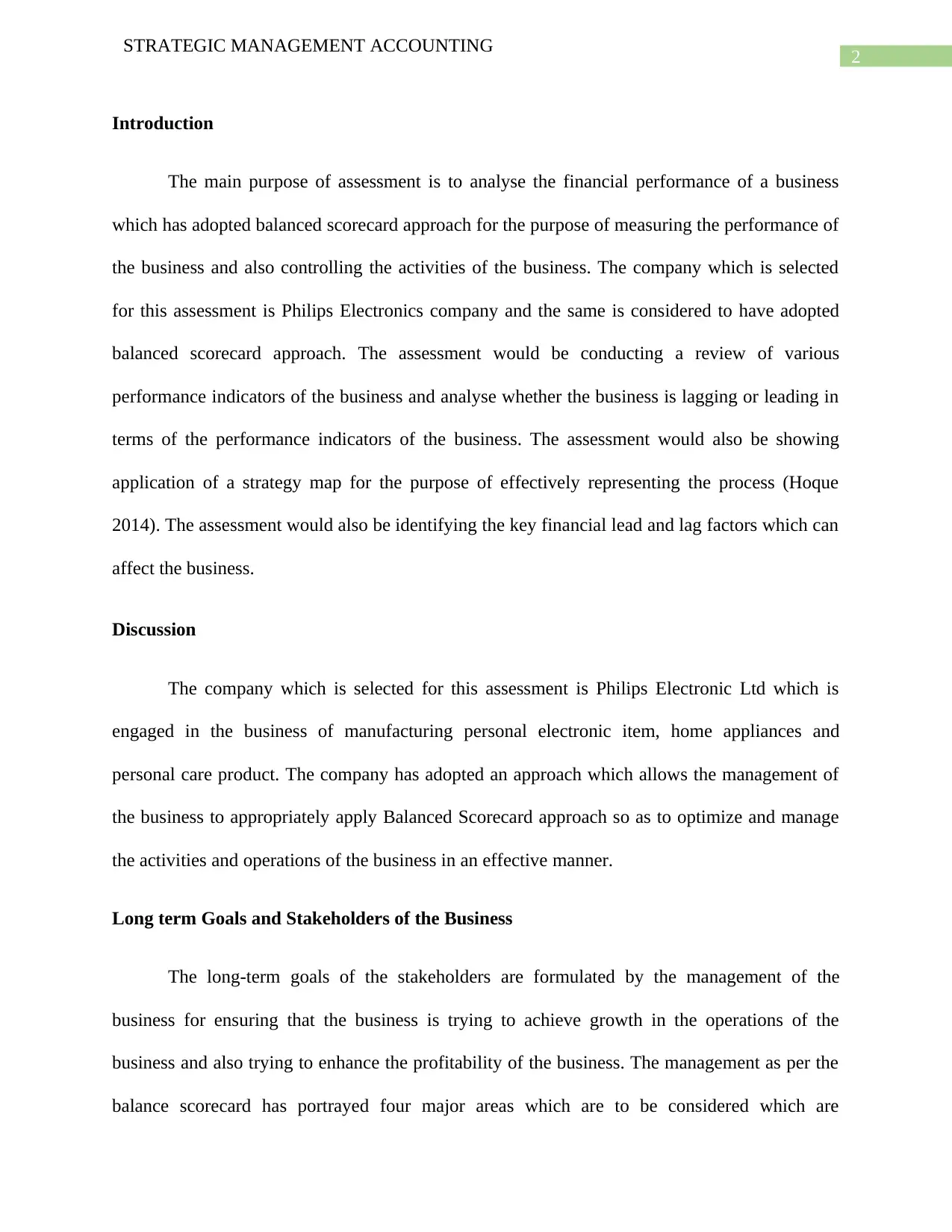
2
STRATEGIC MANAGEMENT ACCOUNTING
Introduction
The main purpose of assessment is to analyse the financial performance of a business
which has adopted balanced scorecard approach for the purpose of measuring the performance of
the business and also controlling the activities of the business. The company which is selected
for this assessment is Philips Electronics company and the same is considered to have adopted
balanced scorecard approach. The assessment would be conducting a review of various
performance indicators of the business and analyse whether the business is lagging or leading in
terms of the performance indicators of the business. The assessment would also be showing
application of a strategy map for the purpose of effectively representing the process (Hoque
2014). The assessment would also be identifying the key financial lead and lag factors which can
affect the business.
Discussion
The company which is selected for this assessment is Philips Electronic Ltd which is
engaged in the business of manufacturing personal electronic item, home appliances and
personal care product. The company has adopted an approach which allows the management of
the business to appropriately apply Balanced Scorecard approach so as to optimize and manage
the activities and operations of the business in an effective manner.
Long term Goals and Stakeholders of the Business
The long-term goals of the stakeholders are formulated by the management of the
business for ensuring that the business is trying to achieve growth in the operations of the
business and also trying to enhance the profitability of the business. The management as per the
balance scorecard has portrayed four major areas which are to be considered which are
STRATEGIC MANAGEMENT ACCOUNTING
Introduction
The main purpose of assessment is to analyse the financial performance of a business
which has adopted balanced scorecard approach for the purpose of measuring the performance of
the business and also controlling the activities of the business. The company which is selected
for this assessment is Philips Electronics company and the same is considered to have adopted
balanced scorecard approach. The assessment would be conducting a review of various
performance indicators of the business and analyse whether the business is lagging or leading in
terms of the performance indicators of the business. The assessment would also be showing
application of a strategy map for the purpose of effectively representing the process (Hoque
2014). The assessment would also be identifying the key financial lead and lag factors which can
affect the business.
Discussion
The company which is selected for this assessment is Philips Electronic Ltd which is
engaged in the business of manufacturing personal electronic item, home appliances and
personal care product. The company has adopted an approach which allows the management of
the business to appropriately apply Balanced Scorecard approach so as to optimize and manage
the activities and operations of the business in an effective manner.
Long term Goals and Stakeholders of the Business
The long-term goals of the stakeholders are formulated by the management of the
business for ensuring that the business is trying to achieve growth in the operations of the
business and also trying to enhance the profitability of the business. The management as per the
balance scorecard has portrayed four major areas which are to be considered which are
⊘ This is a preview!⊘
Do you want full access?
Subscribe today to unlock all pages.

Trusted by 1+ million students worldwide
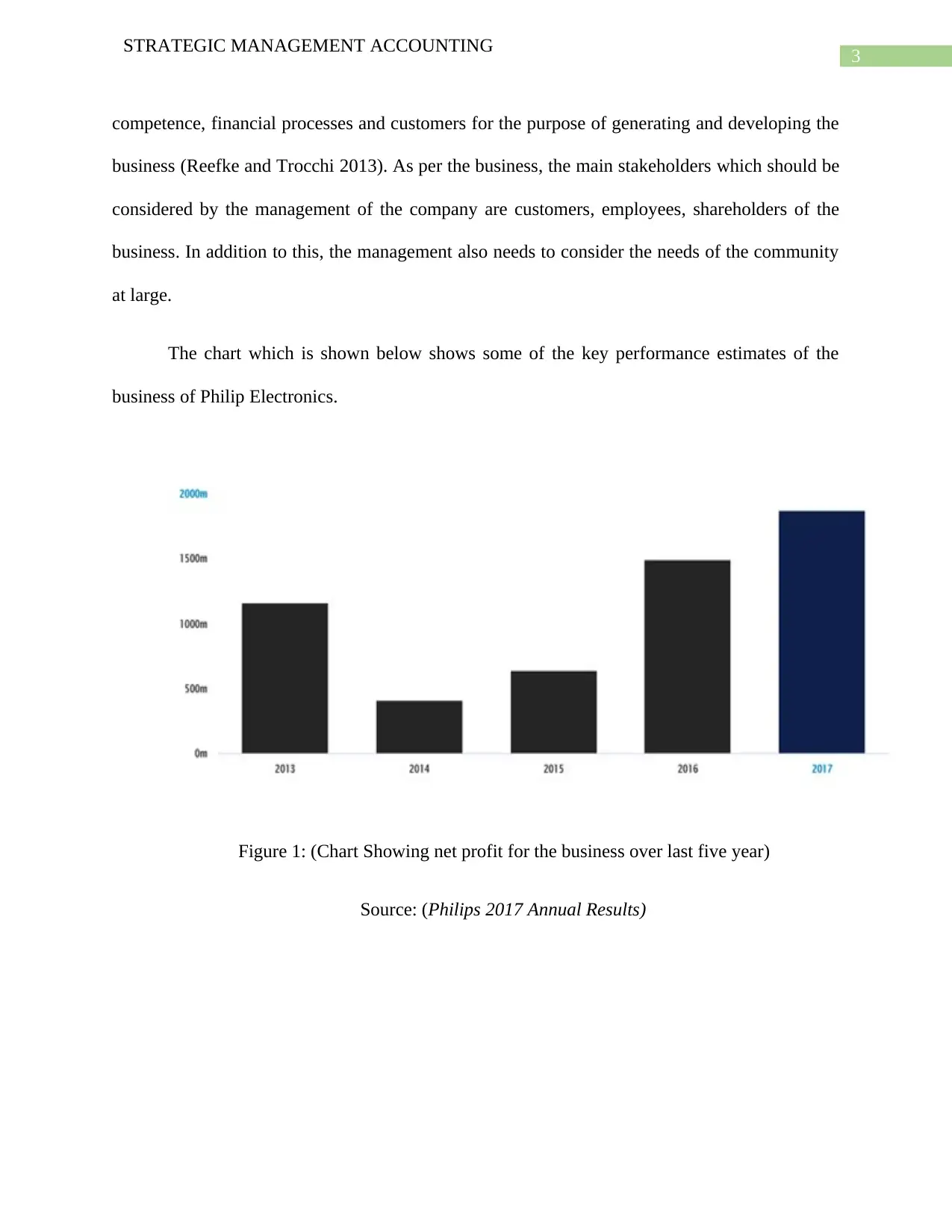
3
STRATEGIC MANAGEMENT ACCOUNTING
competence, financial processes and customers for the purpose of generating and developing the
business (Reefke and Trocchi 2013). As per the business, the main stakeholders which should be
considered by the management of the company are customers, employees, shareholders of the
business. In addition to this, the management also needs to consider the needs of the community
at large.
The chart which is shown below shows some of the key performance estimates of the
business of Philip Electronics.
Figure 1: (Chart Showing net profit for the business over last five year)
Source: (Philips 2017 Annual Results)
STRATEGIC MANAGEMENT ACCOUNTING
competence, financial processes and customers for the purpose of generating and developing the
business (Reefke and Trocchi 2013). As per the business, the main stakeholders which should be
considered by the management of the company are customers, employees, shareholders of the
business. In addition to this, the management also needs to consider the needs of the community
at large.
The chart which is shown below shows some of the key performance estimates of the
business of Philip Electronics.
Figure 1: (Chart Showing net profit for the business over last five year)
Source: (Philips 2017 Annual Results)
Paraphrase This Document
Need a fresh take? Get an instant paraphrase of this document with our AI Paraphraser
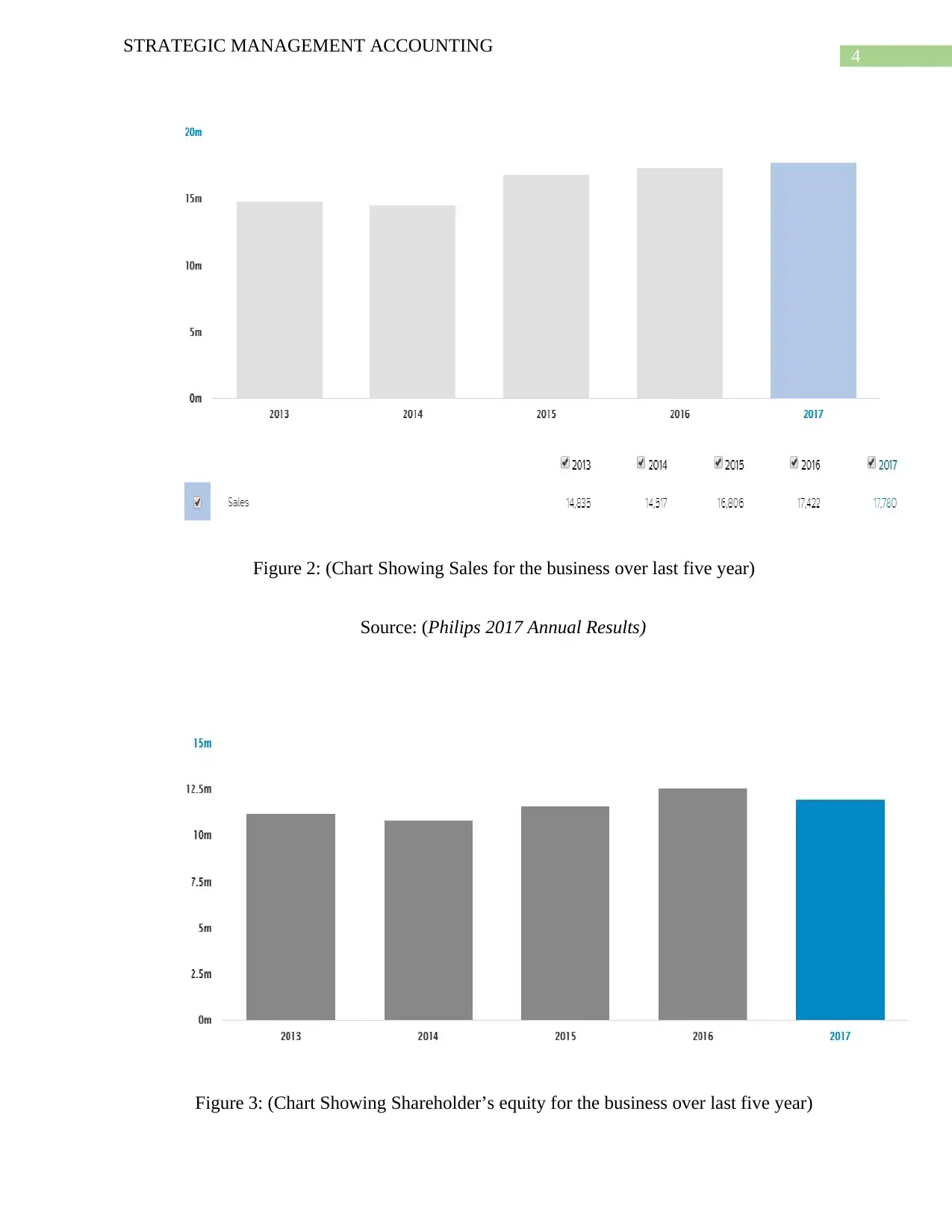
4
STRATEGIC MANAGEMENT ACCOUNTING
Figure 2: (Chart Showing Sales for the business over last five year)
Source: (Philips 2017 Annual Results)
Figure 3: (Chart Showing Shareholder’s equity for the business over last five year)
STRATEGIC MANAGEMENT ACCOUNTING
Figure 2: (Chart Showing Sales for the business over last five year)
Source: (Philips 2017 Annual Results)
Figure 3: (Chart Showing Shareholder’s equity for the business over last five year)
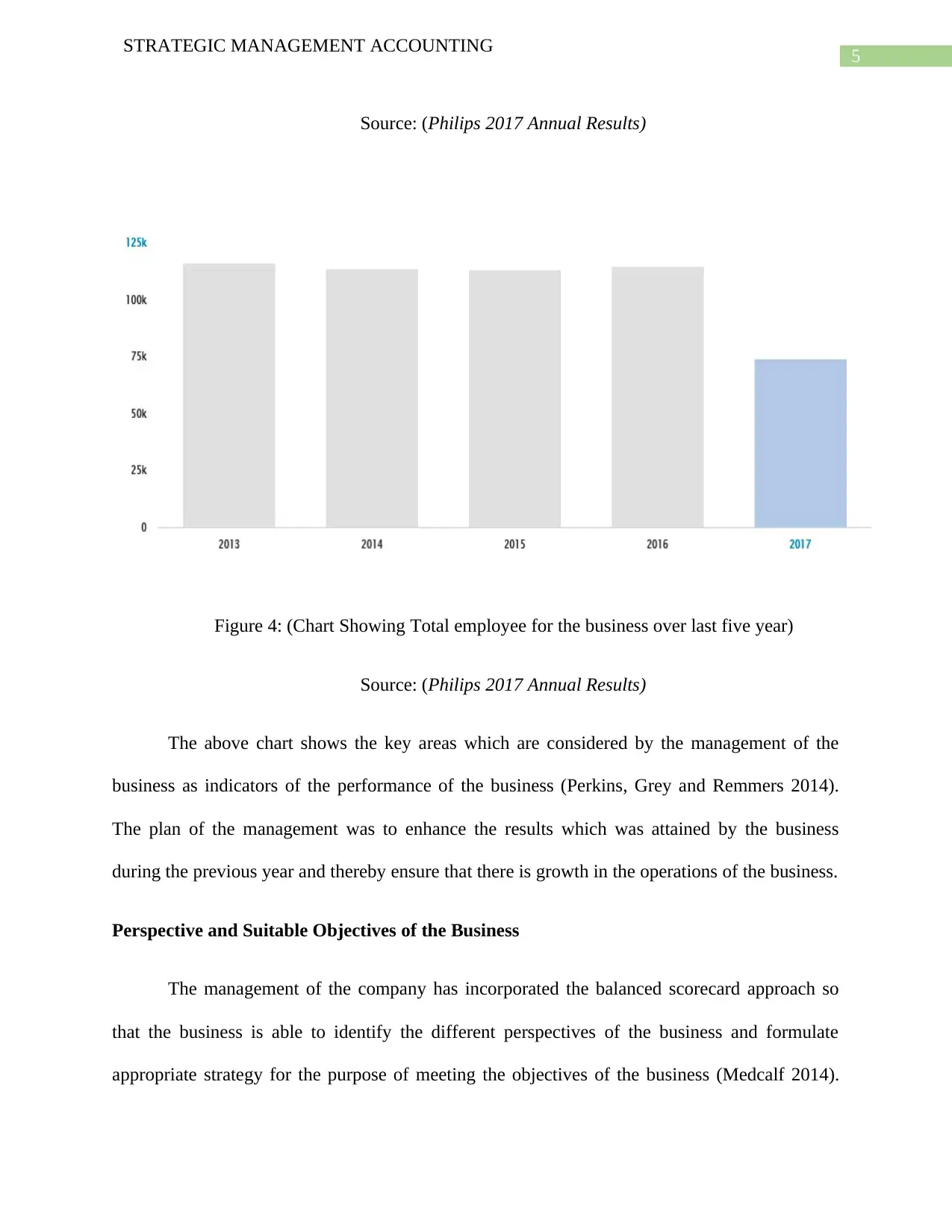
5
STRATEGIC MANAGEMENT ACCOUNTING
Source: (Philips 2017 Annual Results)
Figure 4: (Chart Showing Total employee for the business over last five year)
Source: (Philips 2017 Annual Results)
The above chart shows the key areas which are considered by the management of the
business as indicators of the performance of the business (Perkins, Grey and Remmers 2014).
The plan of the management was to enhance the results which was attained by the business
during the previous year and thereby ensure that there is growth in the operations of the business.
Perspective and Suitable Objectives of the Business
The management of the company has incorporated the balanced scorecard approach so
that the business is able to identify the different perspectives of the business and formulate
appropriate strategy for the purpose of meeting the objectives of the business (Medcalf 2014).
STRATEGIC MANAGEMENT ACCOUNTING
Source: (Philips 2017 Annual Results)
Figure 4: (Chart Showing Total employee for the business over last five year)
Source: (Philips 2017 Annual Results)
The above chart shows the key areas which are considered by the management of the
business as indicators of the performance of the business (Perkins, Grey and Remmers 2014).
The plan of the management was to enhance the results which was attained by the business
during the previous year and thereby ensure that there is growth in the operations of the business.
Perspective and Suitable Objectives of the Business
The management of the company has incorporated the balanced scorecard approach so
that the business is able to identify the different perspectives of the business and formulate
appropriate strategy for the purpose of meeting the objectives of the business (Medcalf 2014).
⊘ This is a preview!⊘
Do you want full access?
Subscribe today to unlock all pages.

Trusted by 1+ million students worldwide
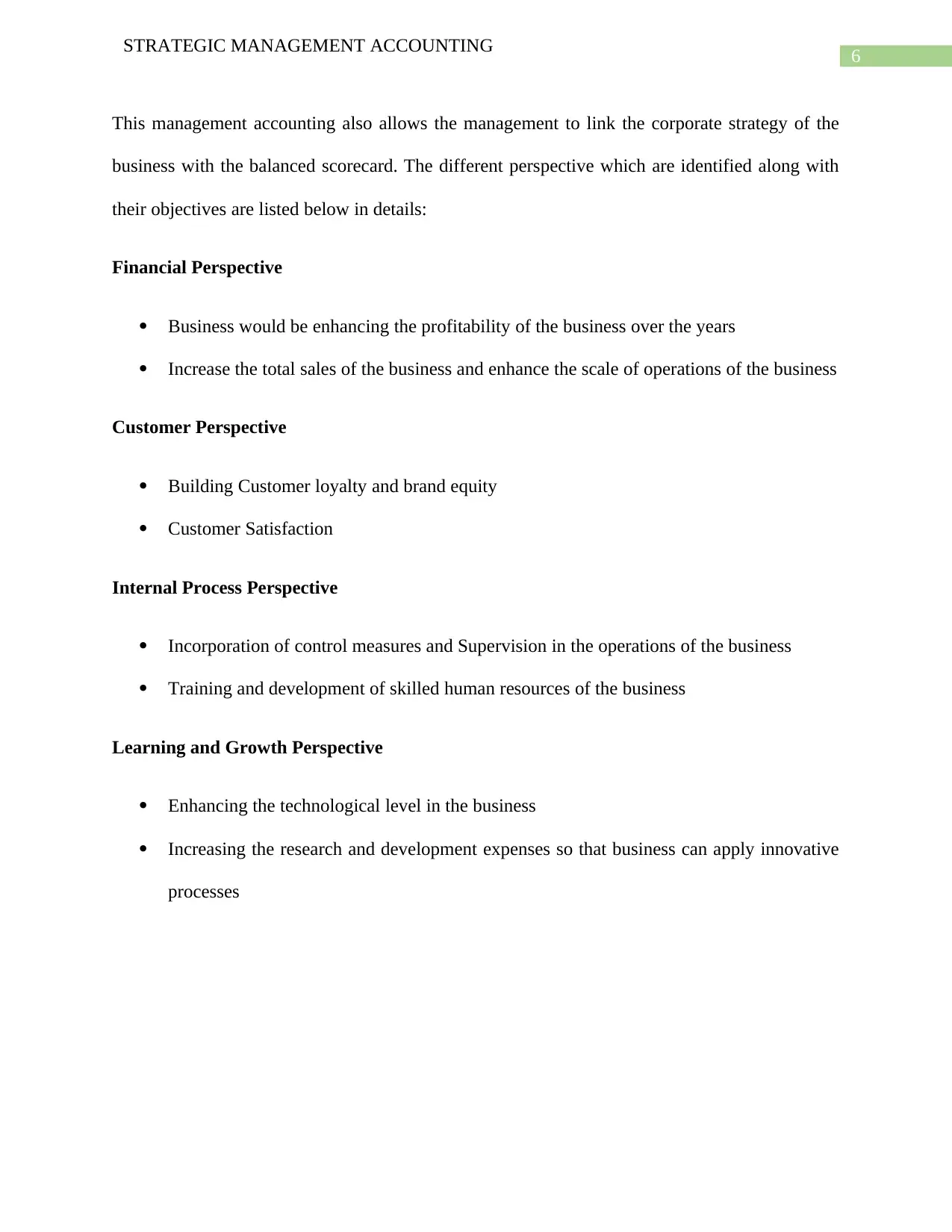
6
STRATEGIC MANAGEMENT ACCOUNTING
This management accounting also allows the management to link the corporate strategy of the
business with the balanced scorecard. The different perspective which are identified along with
their objectives are listed below in details:
Financial Perspective
Business would be enhancing the profitability of the business over the years
Increase the total sales of the business and enhance the scale of operations of the business
Customer Perspective
Building Customer loyalty and brand equity
Customer Satisfaction
Internal Process Perspective
Incorporation of control measures and Supervision in the operations of the business
Training and development of skilled human resources of the business
Learning and Growth Perspective
Enhancing the technological level in the business
Increasing the research and development expenses so that business can apply innovative
processes
STRATEGIC MANAGEMENT ACCOUNTING
This management accounting also allows the management to link the corporate strategy of the
business with the balanced scorecard. The different perspective which are identified along with
their objectives are listed below in details:
Financial Perspective
Business would be enhancing the profitability of the business over the years
Increase the total sales of the business and enhance the scale of operations of the business
Customer Perspective
Building Customer loyalty and brand equity
Customer Satisfaction
Internal Process Perspective
Incorporation of control measures and Supervision in the operations of the business
Training and development of skilled human resources of the business
Learning and Growth Perspective
Enhancing the technological level in the business
Increasing the research and development expenses so that business can apply innovative
processes
Paraphrase This Document
Need a fresh take? Get an instant paraphrase of this document with our AI Paraphraser
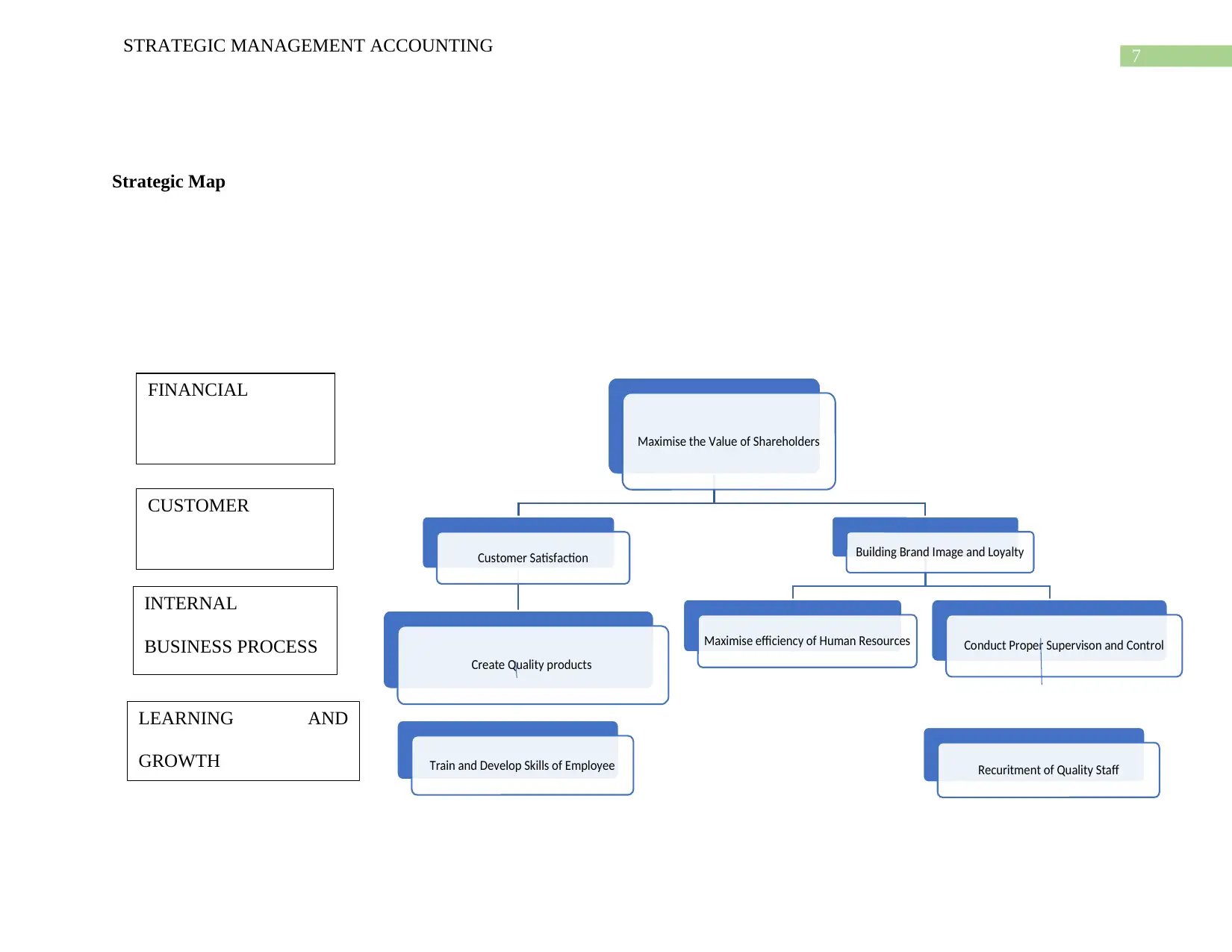
7
STRATEGIC MANAGEMENT ACCOUNTING
Strategic Map
Maximise the Value of Shareholders
Building Brand Image and Loyalty
Conduct Proper Supervison and ControlMaximise efficiency of Human Resources
Customer Satisfaction
Create Quality products
Recuritment of Quality StaffTrain and Develop Skills of Employee
FINANCIAL
CUSTOMER
INTERNAL
BUSINESS PROCESS
LEARNING AND
GROWTH
STRATEGIC MANAGEMENT ACCOUNTING
Strategic Map
Maximise the Value of Shareholders
Building Brand Image and Loyalty
Conduct Proper Supervison and ControlMaximise efficiency of Human Resources
Customer Satisfaction
Create Quality products
Recuritment of Quality StaffTrain and Develop Skills of Employee
FINANCIAL
CUSTOMER
INTERNAL
BUSINESS PROCESS
LEARNING AND
GROWTH
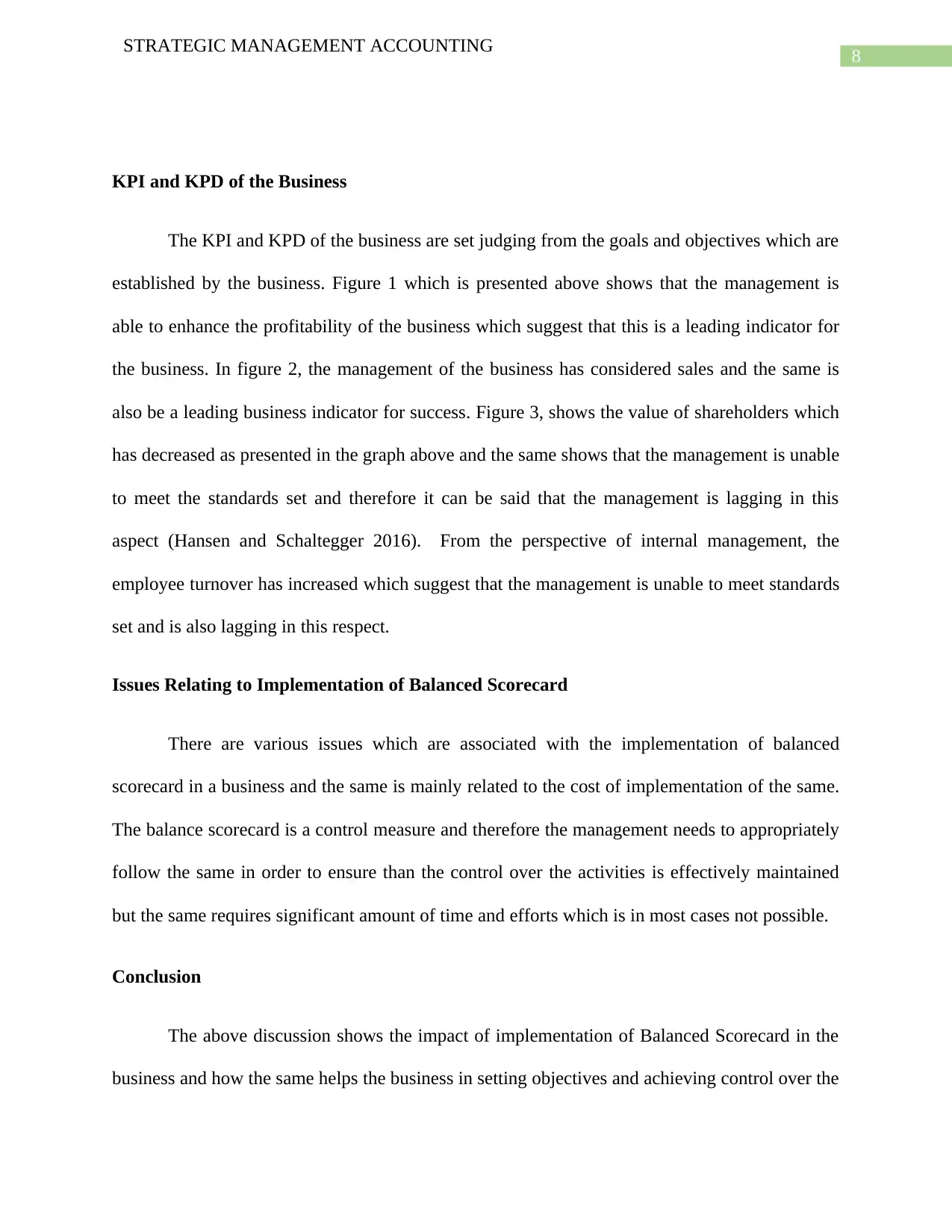
8
STRATEGIC MANAGEMENT ACCOUNTING
KPI and KPD of the Business
The KPI and KPD of the business are set judging from the goals and objectives which are
established by the business. Figure 1 which is presented above shows that the management is
able to enhance the profitability of the business which suggest that this is a leading indicator for
the business. In figure 2, the management of the business has considered sales and the same is
also be a leading business indicator for success. Figure 3, shows the value of shareholders which
has decreased as presented in the graph above and the same shows that the management is unable
to meet the standards set and therefore it can be said that the management is lagging in this
aspect (Hansen and Schaltegger 2016). From the perspective of internal management, the
employee turnover has increased which suggest that the management is unable to meet standards
set and is also lagging in this respect.
Issues Relating to Implementation of Balanced Scorecard
There are various issues which are associated with the implementation of balanced
scorecard in a business and the same is mainly related to the cost of implementation of the same.
The balance scorecard is a control measure and therefore the management needs to appropriately
follow the same in order to ensure than the control over the activities is effectively maintained
but the same requires significant amount of time and efforts which is in most cases not possible.
Conclusion
The above discussion shows the impact of implementation of Balanced Scorecard in the
business and how the same helps the business in setting objectives and achieving control over the
STRATEGIC MANAGEMENT ACCOUNTING
KPI and KPD of the Business
The KPI and KPD of the business are set judging from the goals and objectives which are
established by the business. Figure 1 which is presented above shows that the management is
able to enhance the profitability of the business which suggest that this is a leading indicator for
the business. In figure 2, the management of the business has considered sales and the same is
also be a leading business indicator for success. Figure 3, shows the value of shareholders which
has decreased as presented in the graph above and the same shows that the management is unable
to meet the standards set and therefore it can be said that the management is lagging in this
aspect (Hansen and Schaltegger 2016). From the perspective of internal management, the
employee turnover has increased which suggest that the management is unable to meet standards
set and is also lagging in this respect.
Issues Relating to Implementation of Balanced Scorecard
There are various issues which are associated with the implementation of balanced
scorecard in a business and the same is mainly related to the cost of implementation of the same.
The balance scorecard is a control measure and therefore the management needs to appropriately
follow the same in order to ensure than the control over the activities is effectively maintained
but the same requires significant amount of time and efforts which is in most cases not possible.
Conclusion
The above discussion shows the impact of implementation of Balanced Scorecard in the
business and how the same helps the business in setting objectives and achieving control over the
⊘ This is a preview!⊘
Do you want full access?
Subscribe today to unlock all pages.

Trusted by 1+ million students worldwide
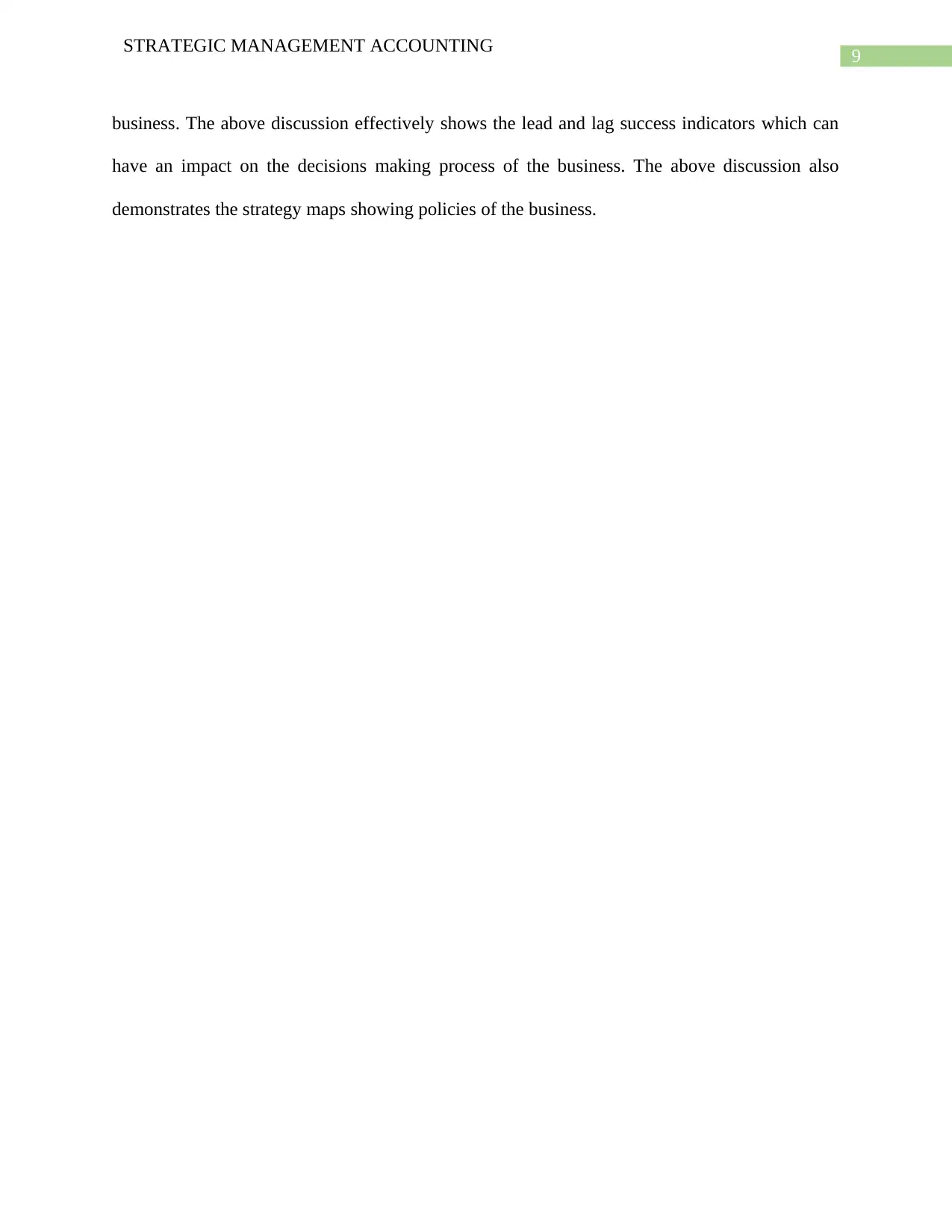
9
STRATEGIC MANAGEMENT ACCOUNTING
business. The above discussion effectively shows the lead and lag success indicators which can
have an impact on the decisions making process of the business. The above discussion also
demonstrates the strategy maps showing policies of the business.
STRATEGIC MANAGEMENT ACCOUNTING
business. The above discussion effectively shows the lead and lag success indicators which can
have an impact on the decisions making process of the business. The above discussion also
demonstrates the strategy maps showing policies of the business.
Paraphrase This Document
Need a fresh take? Get an instant paraphrase of this document with our AI Paraphraser
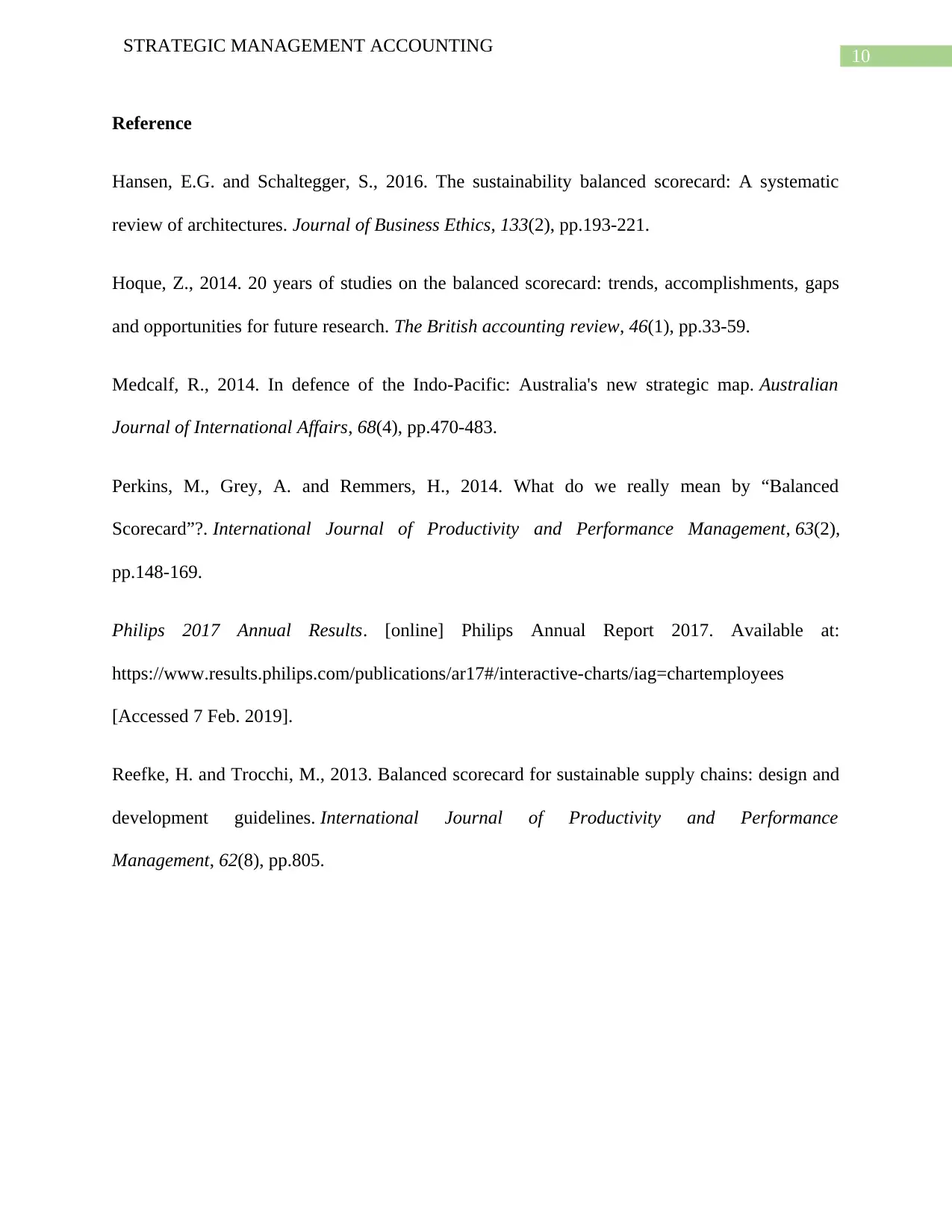
10
STRATEGIC MANAGEMENT ACCOUNTING
Reference
Hansen, E.G. and Schaltegger, S., 2016. The sustainability balanced scorecard: A systematic
review of architectures. Journal of Business Ethics, 133(2), pp.193-221.
Hoque, Z., 2014. 20 years of studies on the balanced scorecard: trends, accomplishments, gaps
and opportunities for future research. The British accounting review, 46(1), pp.33-59.
Medcalf, R., 2014. In defence of the Indo-Pacific: Australia's new strategic map. Australian
Journal of International Affairs, 68(4), pp.470-483.
Perkins, M., Grey, A. and Remmers, H., 2014. What do we really mean by “Balanced
Scorecard”?. International Journal of Productivity and Performance Management, 63(2),
pp.148-169.
Philips 2017 Annual Results. [online] Philips Annual Report 2017. Available at:
https://www.results.philips.com/publications/ar17#/interactive-charts/iag=chartemployees
[Accessed 7 Feb. 2019].
Reefke, H. and Trocchi, M., 2013. Balanced scorecard for sustainable supply chains: design and
development guidelines. International Journal of Productivity and Performance
Management, 62(8), pp.805.
STRATEGIC MANAGEMENT ACCOUNTING
Reference
Hansen, E.G. and Schaltegger, S., 2016. The sustainability balanced scorecard: A systematic
review of architectures. Journal of Business Ethics, 133(2), pp.193-221.
Hoque, Z., 2014. 20 years of studies on the balanced scorecard: trends, accomplishments, gaps
and opportunities for future research. The British accounting review, 46(1), pp.33-59.
Medcalf, R., 2014. In defence of the Indo-Pacific: Australia's new strategic map. Australian
Journal of International Affairs, 68(4), pp.470-483.
Perkins, M., Grey, A. and Remmers, H., 2014. What do we really mean by “Balanced
Scorecard”?. International Journal of Productivity and Performance Management, 63(2),
pp.148-169.
Philips 2017 Annual Results. [online] Philips Annual Report 2017. Available at:
https://www.results.philips.com/publications/ar17#/interactive-charts/iag=chartemployees
[Accessed 7 Feb. 2019].
Reefke, H. and Trocchi, M., 2013. Balanced scorecard for sustainable supply chains: design and
development guidelines. International Journal of Productivity and Performance
Management, 62(8), pp.805.
1 out of 11
Related Documents
Your All-in-One AI-Powered Toolkit for Academic Success.
+13062052269
info@desklib.com
Available 24*7 on WhatsApp / Email
![[object Object]](/_next/static/media/star-bottom.7253800d.svg)
Unlock your academic potential
Copyright © 2020–2025 A2Z Services. All Rights Reserved. Developed and managed by ZUCOL.




